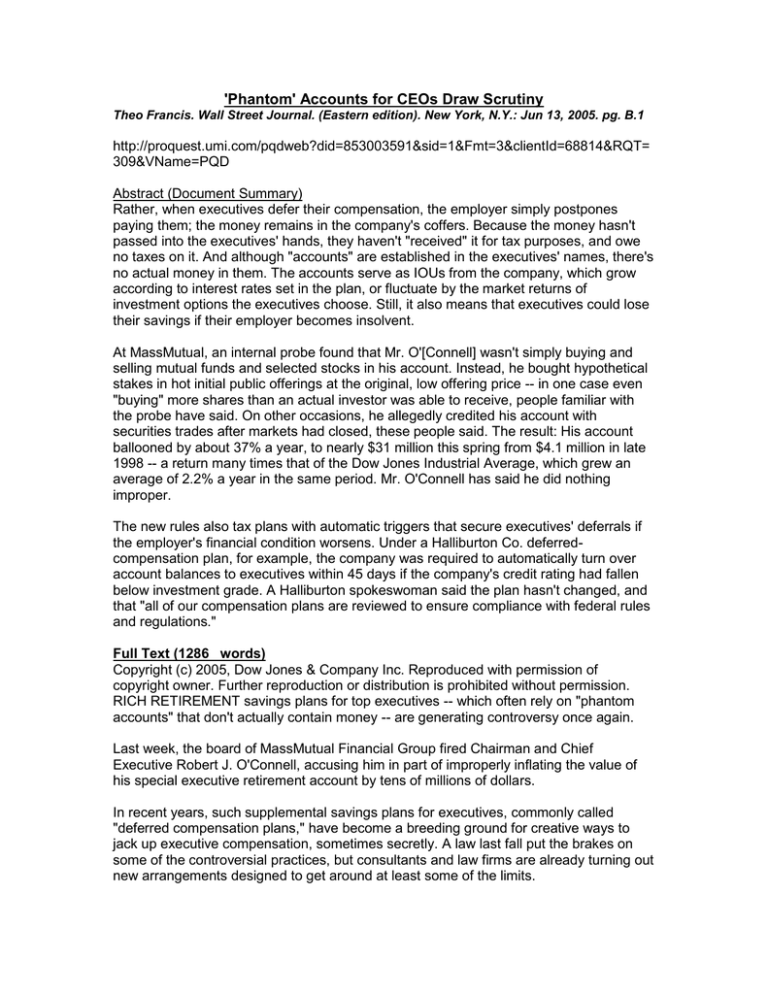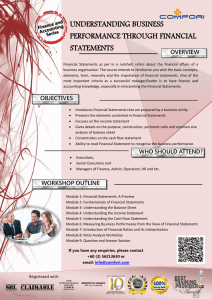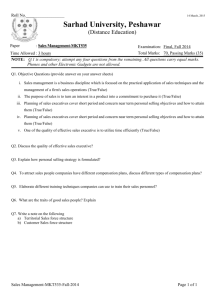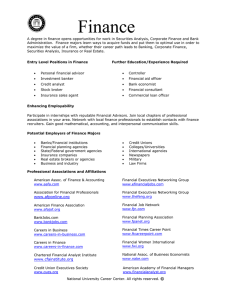'Phantom' Accounts for CEOs Draw Scrutiny
advertisement

'Phantom' Accounts for CEOs Draw Scrutiny Theo Francis. Wall Street Journal. (Eastern edition). New York, N.Y.: Jun 13, 2005. pg. B.1 http://proquest.umi.com/pqdweb?did=853003591&sid=1&Fmt=3&clientId=68814&RQT= 309&VName=PQD Abstract (Document Summary) Rather, when executives defer their compensation, the employer simply postpones paying them; the money remains in the company's coffers. Because the money hasn't passed into the executives' hands, they haven't "received" it for tax purposes, and owe no taxes on it. And although "accounts" are established in the executives' names, there's no actual money in them. The accounts serve as IOUs from the company, which grow according to interest rates set in the plan, or fluctuate by the market returns of investment options the executives choose. Still, it also means that executives could lose their savings if their employer becomes insolvent. At MassMutual, an internal probe found that Mr. O'[Connell] wasn't simply buying and selling mutual funds and selected stocks in his account. Instead, he bought hypothetical stakes in hot initial public offerings at the original, low offering price -- in one case even "buying" more shares than an actual investor was able to receive, people familiar with the probe have said. On other occasions, he allegedly credited his account with securities trades after markets had closed, these people said. The result: His account ballooned by about 37% a year, to nearly $31 million this spring from $4.1 million in late 1998 -- a return many times that of the Dow Jones Industrial Average, which grew an average of 2.2% a year in the same period. Mr. O'Connell has said he did nothing improper. The new rules also tax plans with automatic triggers that secure executives' deferrals if the employer's financial condition worsens. Under a Halliburton Co. deferredcompensation plan, for example, the company was required to automatically turn over account balances to executives within 45 days if the company's credit rating had fallen below investment grade. A Halliburton spokeswoman said the plan hasn't changed, and that "all of our compensation plans are reviewed to ensure compliance with federal rules and regulations." Full Text (1286 words) Copyright (c) 2005, Dow Jones & Company Inc. Reproduced with permission of copyright owner. Further reproduction or distribution is prohibited without permission. RICH RETIREMENT savings plans for top executives -- which often rely on "phantom accounts" that don't actually contain money -- are generating controversy once again. Last week, the board of MassMutual Financial Group fired Chairman and Chief Executive Robert J. O'Connell, accusing him in part of improperly inflating the value of his special executive retirement account by tens of millions of dollars. In recent years, such supplemental savings plans for executives, commonly called "deferred compensation plans," have become a breeding ground for creative ways to jack up executive compensation, sometimes secretly. A law last fall put the brakes on some of the controversial practices, but consultants and law firms are already turning out new arrangements designed to get around at least some of the limits. Essentially, deferred-compensation plans function like super-401(k)s for top executives and highly paid employees. They often come in two flavors: A mass-market version available to any highly rewarded employee whose compensation exceeds certain Internal Revenue Service retirement-plan limits, and supercharged versions available only to the most senior managers. Top executives have often been able to defer up to 100% of their salary, bonus and long-term incentive pay under such plans, which increasingly also have let executives defer gains from exercising stock options. Deferring such compensation until after an executive has retired offers tax benefits that can improve the investment returns the executive receives over the long term. A key feature of the arrangements is that they depend on hypothetical, or phantom, accounts. Unlike a 401(k), in which employees defer some of their pay into an actual trust, with actual dollars that belongs to them, there's no money in a deferred compensation account. Rather, when executives defer their compensation, the employer simply postpones paying them; the money remains in the company's coffers. Because the money hasn't passed into the executives' hands, they haven't "received" it for tax purposes, and owe no taxes on it. And although "accounts" are established in the executives' names, there's no actual money in them. The accounts serve as IOUs from the company, which grow according to interest rates set in the plan, or fluctuate by the market returns of investment options the executives choose. Still, it also means that executives could lose their savings if their employer becomes insolvent. Another way to look at it is that the phantom account is essentially a loan to the company by an executive. Some companies provide fixed- guaranteed returns on the deferrals. General Electric Co., for example, pays between 9.5% and 14% annual interest on salary deferrals made by executives in recent years, a spokesman says. Commonly, executives deferring some or all of their pay can choose to "invest" the sums in funds whose returns mirror those of mutual funds available in the company's regular 401(k). At some companies, executives have been provided the option of "investing" in proprietary hedge or private-equity funds. As in a 401(k) plan, companies sometimes kick in additional contributions, which can equal 20% or 25% of the executive's deferral. The GE spokesman says that its bonus deferral plan, with 3,500 participants, offers three hypothetical investment options -- one mirroring GE stock returns, another tracking a large stock index and a third that mimics a money-market fund -- with a limit of four reallocations a year and insider-trading restrictions. At MassMutual, an internal probe found that Mr. O'Connell wasn't simply buying and selling mutual funds and selected stocks in his account. Instead, he bought hypothetical stakes in hot initial public offerings at the original, low offering price -- in one case even "buying" more shares than an actual investor was able to receive, people familiar with the probe have said. On other occasions, he allegedly credited his account with securities trades after markets had closed, these people said. The result: His account ballooned by about 37% a year, to nearly $31 million this spring from $4.1 million in late 1998 -- a return many times that of the Dow Jones Industrial Average, which grew an average of 2.2% a year in the same period. Mr. O'Connell has said he did nothing improper. Even without alleged improprieties, companies can rack up huge, often unfunded obligations to their executive deferred-compensation plans. GE, for example, owes executives about $2.4 billion, a figure that has held steady for the past couple of years, a GE spokesman says. GE has previously called the figure insignificant for a company its size. For investors, deciphering the ins and outs of deferred compensation -- or the size of a company's deferred-compensation liability -- is tricky. Companies disclose how much executives are paid, but rarely how much of it they defer. Securities and Exchange Commission rules haven't required companies to report the full interest they pay out on deferrals, just the amount that exceeds a "market" interest rate set by the IRS. Although documents governing the plans are supposed to be filed with the SEC, they can be hard to find. Deferred compensation first came under scrutiny in recent years amid the late-2001 collapse of Enron Corp., which had accumulated some $220 million in deferredcompensation liabilities for about 285 executives. About three dozen of those executives withdrew $32 million from their accounts in the year before Enron filed for bankruptcy, most under a "haircut" provision allowing withdrawals at any time for executives willing to give up 10% of the withdrawal. Other Enron executives, facing the loss of some or all of their deferrals in Enron's bankruptcy, cried foul. Then, in 2003, several airlines facing financial difficulties sought to protect top managers' deferrals by transferring them into secure trusts. Those moves came even as the airlines sought pension and other pay concessions from unionized employees. New tax rules passed by Congress lastfall were aimed at ending some of the more controversial deferred-compensation features, by taxing executives on their deferrals unless the employers' plans met a variety of rules. For example, "haircut" features like that at Enron are likely to vanish, thanks to rules requiring executives to set fixed dates to collect the deferrals and forbidding them from collecting sooner than originally scheduled. The new rules also tax plans with automatic triggers that secure executives' deferrals if the employer's financial condition worsens. Under a Halliburton Co. deferredcompensation plan, for example, the company was required to automatically turn over account balances to executives within 45 days if the company's credit rating had fallen below investment grade. A Halliburton spokeswoman said the plan hasn't changed, and that "all of our compensation plans are reviewed to ensure compliance with federal rules and regulations." Prior to last year's tax-rule changes, deferred compensation plans had increasingly become another way to boost executive pay, rather than a tool to help them save some of their existing compensation, says Pearl Meyer, founder and chairman of executiveconsulting firm Pearl Meyer & Partners. "What we're trying to do is get back to basics and use these for savings," Ms. Meyer says. A number of compensation attorneys and consultants are already devising ways around some of the new rules. One law firm, for example, says it has charted a partial way around rules that prevent executives from postponing scheduled withdrawals by less than five years. The law firm recommends slicing deferrals into multiple accounts, deferring each for a minimal period, and then staggering further deferrals for five-year periods as needed to gain "maximum flexibility" on collecting. --Hidden Riches Executives can often postpone receiving -- and paying taxes on -- their pay by deferring up to 100% of: -- Salary -- Bonus -- Long-term incentive pay -- Gains from some stock options Some employers boost their executives' compensation by offering perks such as: -- Matching contributions -- Guaranteed, above-market interest payments -- Investment options that include hedge funds More Like This - Find similar documents Author(s): Theo Francis Language: English Publication title: Wall Street Journal





